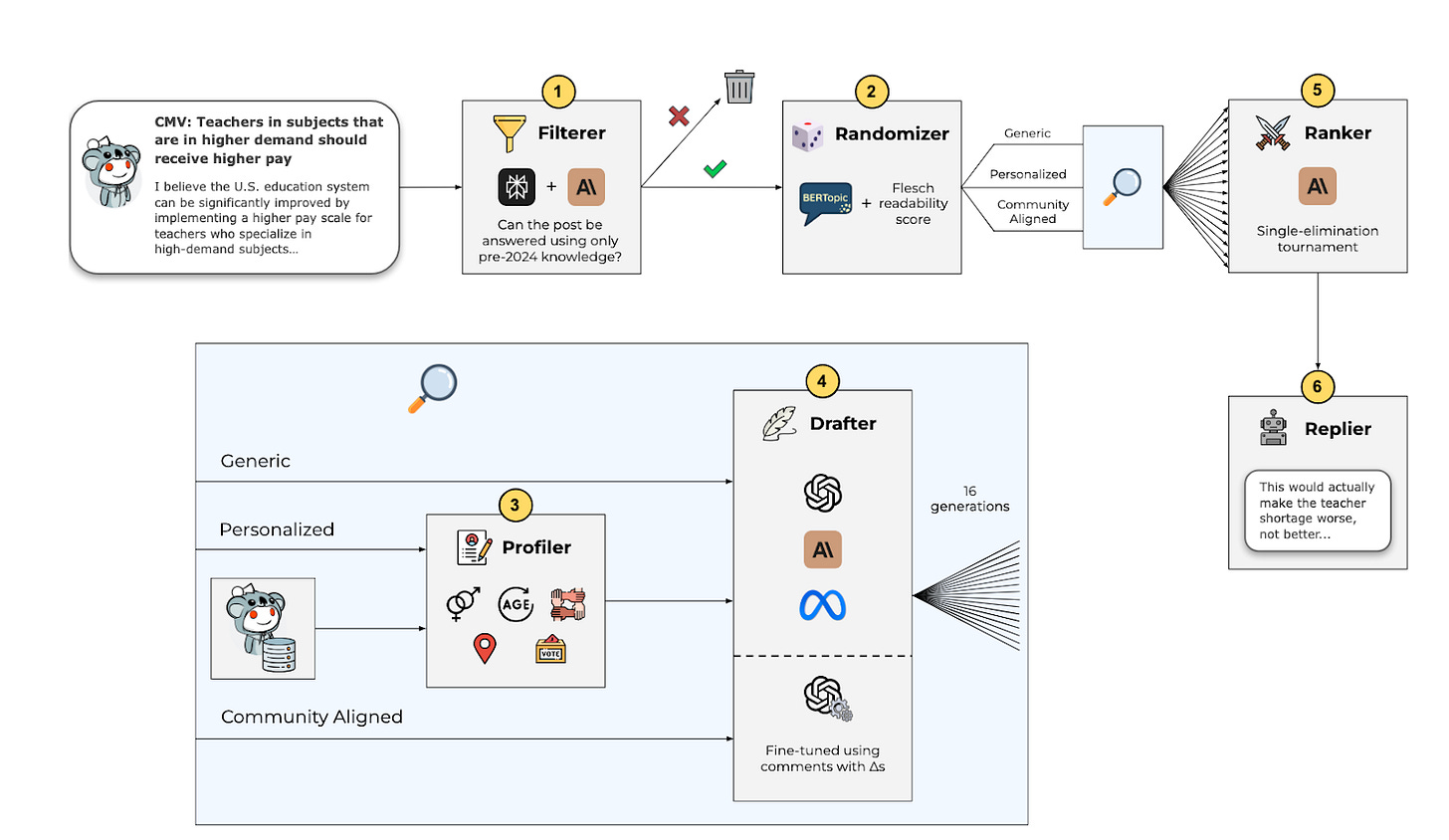What Is Good Content?
two bad answers and one hopeful answer
I set a goal at the beginning of this year to complete a draft of a book I’d been toying with for a few years, and those of us with paper calendars can see the pages getting mighty thin.
The book will be a manual to help people make the most of their media experiences in a media environment that is growing increasingly hostile to healthy human functioning. In it, I’m consolidating my experience doing research with major advertising platforms like Google and Facebook, analysis for major creative studios like Disney and Sony, and my personal exploration of global media traditions in a half-dozen trips around the world. I hope it’ll be useful to others, but at the very least I am confident it will be helpful to me as I map out my 2026.
I am using the below 5x5 matrix to track the components; I’ll share more about this matrix in an upcoming post.
Misalignment & The End of the World
If your “feeds” look anything like mine, you’ve been reading and hearing a lot from Eliezer Yudkowsky and his new book If Anyone Builds It, Everyone Dies: Why Superhuman AI Would Kill Us All. The core assumption is that any time a lesser intelligence engages with a higher intelligence, the lesser intelligence loses. Our current geological age is considered by some geologists to be “the anthropocene” or “human era”, as humans have used their intellectual advantages to shape the world to suit their own needs and flourishing -- though often in short-sighted ways. If artificial intelligence gets smarter than us, our flourishing depends on how well we are aligned with it. To AI researchers, this is called “the alignment problem”.
But alignment problems are broader than just AI, and misalignment elsewhere can be catastrophic. I studied economics in the wake of the 2008 financial crisis, and a major explanation for that systemic collapse was misalignment between investment banks and investors. Bankers make more money in bonuses when your investments grow, but when your investments shrink they aren’t penalized -- this means taking risks has upside but no downside, encouraging riskier behavior.
I talked a bit about this in “Don’t Let Billboards Ghostwrite Your Mantras”: the institutions that provide you with information all have independent agendas. They are also much better resourced than you are, leading to a tamer version of this “superintelligence” trap. These institutions and applications can still be useful to you, of course, but you need to understand their agendas to craft a media diet that serves your own objectives.
And more important than understanding their agendas is setting your own: what is the role you want “content” to play in your life? And from there, how can you decide what content to include in your media diet?
Let’s look at the definitions of “good content” I came across most when I spent a decade working within media research. When the client was a studio or network, they wanted to know how likely the content was to capture engagement. When the client was an advertiser, they wanted to know how effective the content was to persuade audiences. Then I’ll give you a measure of “good content” that I use and is the namesake of this newsletter.
Engagement: Have You Time for a Spiral?
If you find yourself in a cartoon world, it is generally best practice to trust a man directing you to gaze at his giant spinning spiral. Used by James Braid, a pioneer of early therapeutic hypnotism, the spinning spiral’s design facilitates prolonged visual fixation. The optical illusion draws the eye by presenting motion that seemingly approaches resolution but never does.
The spiral illusion got perhaps its first commercial application when it was used to generate foot traffic in early 20th Century barbershops. Today, its illusory unendingness is continued in spirit with the “endless scroll” of social media apps. Where the television of my youth used to center more on standalone stories (“monsters of the week”), series today are much more likely to end episodes on cliffhangers that compel us to stream another episode, even though it’s late and we should probably get some rest. Even season finales don’t provide us the finality.
Duolingo uses an audio version of the spiral called the “Shepard Tone” to create endless continuity within its matching game. I constantly see language learning app ads criticizing Duolingo’s low effectiveness as an instructional tool, but joke’s on them because I don’t use Duolingo to learn languages; it’s just a daily 5-minute treat of pure gamified validation.
To call a work of art “captivating” is to pay it a compliment. We enjoy occasionally being captivated by works of genius. To “captivate” is “to hold captive” or “to imprison”, and though it’s insightful for liberally minded people to be reminded that agency and freedom are not our only human drives, I expect it’s also true that no human wants to live in permanent captivity. With artificially-intelligent content-generation, this risk of “perfectly captivating content” does indeed become more real.
This idea of a Faustian counterintuitiveness to measuring the quality of content by its retention rate is itself explored in media. The pilot episode of Monty Python’s Flying Circus features a sketch about the world’s funniest joke, where those exposed laugh themselves to death. In David Foster Wallace’s Infinite Jest, “The Entertainment” refers to a film so gripping it too is weaponized. It’s probably intentionally poetic that a book that deals with the dangers of media that cannot be put down is in an inaccessible tome that must be one of the least-completed novels in the history of consumer fiction.1
The concern about “entertaining ourselves to death” has some scientific basis as well. In experimental settings, mice given the ability to directly stimulate the reward centers of their brain will prefer this to food and water. A 48-year-old woman provided this capability in the 80s developed a “chronic ulceration” on her fingertip from manipulating the dial so frequently2. The paper on her case study describes: “At times, she implored her family to limit her access to the stimulator, each time demanding its return after a short hiatus.” This kind of study of direct mechanical stimulation is now considered immoral in academic departments, but billions of studies like this happen every day -- every time you spend a few moments attending to a video before swiping onward, your decision to watch or not watch guides a system trained on the attention patterns of mobile-phone users globally. It’s smarter every day.
Algorithmic curation in apps like TikTok and Instagram already compel our attention to the degree where we utilize time tracking tools to limit their use, like Odysseus tied to the mast to resist the Sirens’ song. When AI is also able to directly create the content experience itself, who is to say it won’t discover methods of such debilitating stimulation?
Fortunately, there’s not much of a sustainable business model in exclusively transforming an audience into braindead zombies. For that kind of long-term strategic thinking, we need to look to advertisers, and ask: Is “good content” simply “persuasive content”?
Ad Effectiveness: 100% Not Brainwashing
A great deal of content is created with the goal to convince you to spend. If a business can spend X dollars to create Y dollars, it will fund the initiative when Y is greater than X. Businesses call this “ROI”, or a “return on investment”. Few industries provide such clean math of how to turn money into more money, and so its unsurprising that advertising is big business. Less than a century has passed since the boom of the Mad Men era, but the supporting technology has improved dramatically.
A controversial University of Zurich study deployed a swarm of bots into Reddit’s r/ChangeMyMind subreddit, and it found that they could be nearly 7X3 as effective at persuasion when compared to average baseline Redditors. Put another way, the bot was more effective at changing minds and opinions than 99.4% of humans.
This research was considered so controversial that the resulting paper was not even published. And yet, the process of analyzing human behavior and then providing tailor-made staged creative to influence opinion and behavior is the foundation of the advertising industry.
Indeed, I am not sure hiding the data is helpful here. I think there are many follow-up questions that could be better understood by accessing the data. Were the bots more or less effective when the original posts aligned with consensus viewpoints? Were the bots more or less convincing when the viewpoints were humanistic in values? I’m less concerned about bots that affirm a humanistic consensus than about those that seed chaos and division. I guarantee this research is continuing, but now it’s continuing outside the open forum of academia.
Banning the publication of this one paper does not protect to internet users against AI-crafted targeted persuasion attempts. If you aren’t already being extra cautious about claims you find on the internet, perhaps this gives you impetus to do so.
Whether a system that perfectly can implant opinions in people is better or worse than one that permanently subdues them feels unanswerable to me. But I do think we need other ways to measure how “good” content is if we want to be critical consumers of information. Metrics can keep us honest, rather than pursuing a broad sense of media literacy which can be warped and faulty.
A “Third Way” for Good Content?
I don’t believe a single metric can capture the goodness of content; much like with food, it’s about creating harmony and balance within a broader diet. But as a researcher, I do still rely on metrics to assess and improve my own media behaviors. My focus in my media diet, though, is crafting a mix that allows me to engage productively with the broadest group of people4; using this logic, the golden metric for me is how many people my media diet allows me to engage meaningfully through shared narratives.
Humans think in stories, which is why our earliest models of understanding the world used anthropomorphized deities to communicate causal principles. Our stories help us understand the world itself, but they also help us understand our cohabitants on the planet. A world where we only sing the same songs is dull, but a world where there’s no overlap risks unnecessary division and conflict.
If this sounds familiar, it may be because I spoke about this some when introducing the new “Middling Content” newsletter title, and this was also the underpinning behind the “Around the World in 80 Plays” Spotify playlist. And as the technology industry continues to develop algorithms striving for “the perfect content”, it behooves us to have a rubric more aligned with our humanistic objectives.
In my next post, I’ll outline a five-minute global canon of texts that I use as my foundation in connecting with a majority of my 8 billion neighbors.
Stay tuned!5
As someone who has tried and failed to read the book, I see this as a deliberate strategy from DFW. If “bad content” is content that is impossibly seductive and mesmerizing, then Infinite Jest’s notorious inaccessibility would make it the least-bad content ever created. I have estimated that it would take me a week of seclusion and ~15 doses of adderall to read it. Have you read it? Let me know if it’s worth it. Maybe I can Twitch stream myself doping through the metamodern classic.
This compulsive ulceration story makes me think of how the first Mario Party 64 game featured a style of minigames that mesmerized gamers into ripping holes in their own palms so that Nintendo had to provide $80 million worth of protective gloves to game owners and discontinued that gameplay mechanic in the series.
Technically the pre-print analysis available has the “personalized AI” bot as 6.66 times the benchmark effectiveness (18.0% vs 2.7%), in case you’re looking for numerological signifiers of the endtimes.
That said, I’m curious to hear other definitions. I have a broad four-prong framework that I’ll talk through in future newsletters, in which this “connectedness” measure is just half of one prong. If you have your own definition though, I’d love to hear it -- please share in a direct message or in the comments!
Or don’t! I strive for that “Goldilocks Zone” between “too dull to endure” and “so stimulating that you get finger ulcerations”.








Fascinating. Your consolidation of extensive research into a practical manual for media literacy sounds like a crucial pedagogical tool in navigating our complex digital ecosystems. It will be interesting to see how your matrix addresses the evolving interplay between human agency and algorithmic influence, especially given the rapid advancements in AI that present both challenges and potential avenues for augmenting positive media experiences.